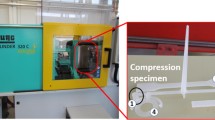Abstract
Tensile deformation of polystyrene carried out under pressure up to 4 kbar has shown that the pressure-transmitting fluid (silicon oil) acts as a stress crazing and cracking agent. Unsealed specimens showed a brittle-to-ductile transition at 2.95 kbar, while specimens sealed with Teflon tape and rubber showed the same transition at only 0.35 kbar.
Analysis of the stress-strain curves for the sealed specimens indicated that the pressure dependency of the craze initiation stress differs from that of shear band initiation stress. The brittle-to-ductile transition occurs when the initiation stresses of both processes become equal.
The principal stress for craze initiation showed almost no pressure dependency, suggesting that crazes initiate when the principal stress level of the tensile specimen reaches a critical value irrespective of the applied hydrostatic pressure. Similarly, no pressure dependency was observed for the principal ductile fracture stress. The pressure dependency of yield stress agreed well with a non-linear pressure dependent von Mises yield criterion.
Similar content being viewed by others
Abbreviations
- P :
-
pressure
- σ T :
-
observed tensile stress
- σ ci :
-
craze initiation stress
- σ y :
-
upper yield stress
- σ f :
-
fracture stress
- σ 1 :
-
the first principal stress
- σ ci 1 :
-
principal craze initiation stress
- σ f 1 :
-
principal fracture stress
- Τ max(P):
-
maximum shear stress at pressureP
- Τ 0 :
-
maximum shear stress at atmospheric pressure
- Τ oct(P):
-
octahedral shear stress at pressureP
- Τ′ 0 :
-
octahedral shear stress at atmospheric pressure
- σ m :
-
mean normal stress
- T :
-
tensile yield stress at atmospheric pressure
- C :
-
compressive yield stress at atmospheric pressure
References
L. Holliday, J. Mann, G. A. Pogany, H. Pugh andD. A. Gunn,Nature 202 (1964) 381.
H. Pugh, E. F. Chandler, L. Holliday andJ. Mann,Polymer Eng. Sci. 11 (1971) 463.
G. Biglione, E. Baer andS. V. Radcliffe, in “Fracture 1969” Proceeding of the Second International Conference, Brighton, 1969, edited by P. L. Pratt (Chapman and Hall, London, 1969).
S. S. Sternstein andL. Ongchin,A.C.S.Polymer Preprints 10 (1969) 1117.
S. S. Sternstein andF. A. Myers,J. Macromol. Sci. Phys. B8 (1973) 557.
R. J. Oxborough andP. B. Bowden,Phil. Mag. 28 (1973) 547.
A. N. Gent,J. Mater. Sci. 5 (1970) 925.
W. Whitney andR. D. Andrews,J. Polymer Sci. C16 (1967) 2981.
P. B. Bowden andJ. A. Jukes,J. Mater. Sci. 3 (1968) 183.
C. A. Coulomb,Mém. Math. et Phys. 7 (1773) 343.
J. C. Bauwens,J. Polymer Sci. A-2 8 (1970) 893.
R. Raghava, R. M. Caddell andG. S. Y. Yeh,J. Mater. Sci. 8 (1973) 225.
D. R. Mears, K. D. Pae andJ. A. Sauer,J. Appl. Phys. 40 (1969) 4229.
L. A. Davis andC. A. Pampillo,ibid 42 (1971) 4659.
A. W. Christiansen, E. Baer andS. V. Radcliffe,Phil. Mag. 24 (1971) 451.
J. A. Sauer, D. R. Mears andK. D. Pae,Eur. Polymer J. 6 (1970) 1015.
W. I. Vroom andR. F. Westover,SPEJ. 25 (1969) 58.
D. Sardar, S. V. Radcliffe andE. Baer,Polymer Eng. Sci. 8 (1968) 290.
S. B. Ainbinder, M. G. Laka andYu. I. Mairors,Mekkanika Polemerov 1 (1965) 65.
J. Bailey,Modern Plastics 24 (1946) 127.
P. W. Bridgman,Trans. ASM 32 (1944) 553.
M. S. Paterson,J. Appl. Phys. 35 (1964) 176.
G. Das andS. V. Radcliffe,J. Jap. Inst. Metals 9 (1968) 334.
J. Hoare andD. Hull,Phil. Mag. 26 (1972) 443.
S. Rabinowitz, A. R. Krause andP. Beardmore,J. Mater. Sci. 8 (1973) 11.
J. S. Harris, I. M. Ward andJ. S. C. Parry,ibid 6 (1971) 110.
A. S. Argon, R. D. Andrews, J. A. Godrick andW. Whitney,J. Appl. Phys. 39 (1968) 1899.
E. J. Kramer,J. Macromol. Sci. Phys. B10 (1974) 191.
C. B. Bucknell, D. Clayton andW. E. Keast,J. Mater. Sci. 7 (1972) 1443.
M. Higuchi andH. Ishii,Repts. Res. Inst., Appl. Mech. Kyushu University 16 (1968) 69.
S. Wellinghoff andE. Baer, to be published.
S. Rabinowitz, I. M. Ward andJ. S. C. Parry,J. Mater. Sci. 5 (1970) 29.
F. Schleicher,Z. Agnew. Math. Mech. 6 (1926) 199.
G. Binder andF. H. Muller,Kolloid Z. 177 (1961) 129.
R. N. Haward, B. M. Murphy andE. F. T. White,J. Polymer Sci. A-2 9 (1971) 801.
H. Pugh, International Conference on Materials ASTM, Philadelphia USA, February 1964.
Author information
Authors and Affiliations
Rights and permissions
About this article
Cite this article
Matsushige, K., Radcliffe, S.V. & Baer, E. The mechanical behaviour of polystyrene under pressure. J Mater Sci 10, 833–845 (1975). https://doi.org/10.1007/BF01163078
Received:
Accepted:
Issue Date:
DOI: https://doi.org/10.1007/BF01163078




